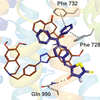issue contents
September 2023 issue

Cover illustration: The redetermination of the crystal structures of Cu2CdSiS4 and Cu2HgSnS4 confirms the previously reported structure types and yields acceptable global instability index (G) values. Here it is demonstrated that accurate data collected on modern instrumentation should be used to reliably calculate bond valence sums and G values. See Treece, Kelly, Rosello, Craig & Aitken [Acta Cryst. (2023), C79, 364–375].
research papers








 access
access




 journal menu
journal menu























